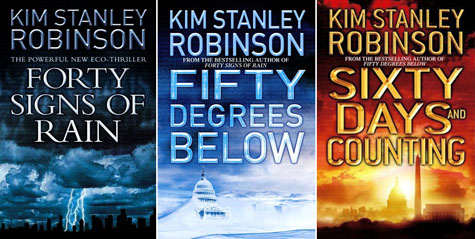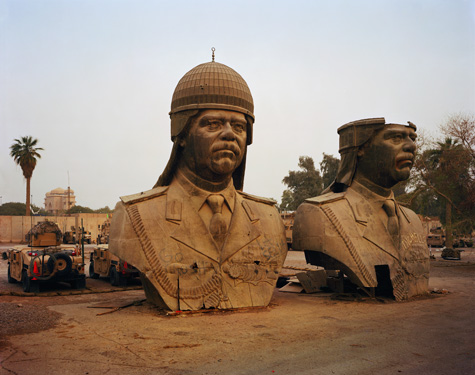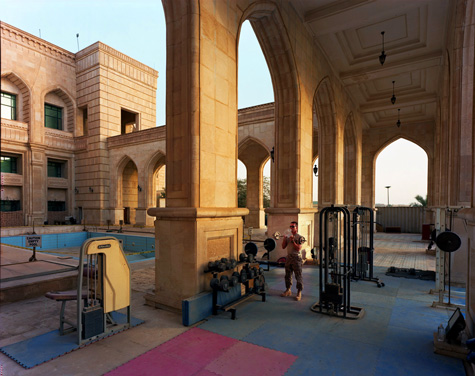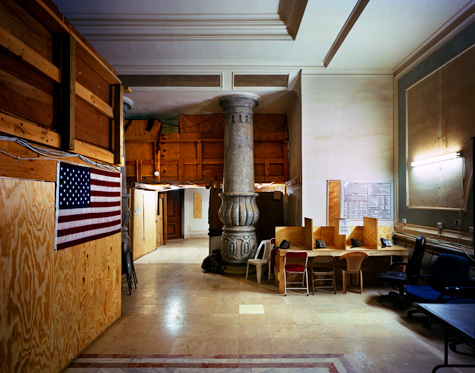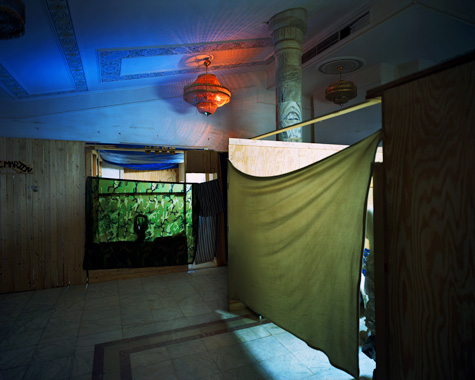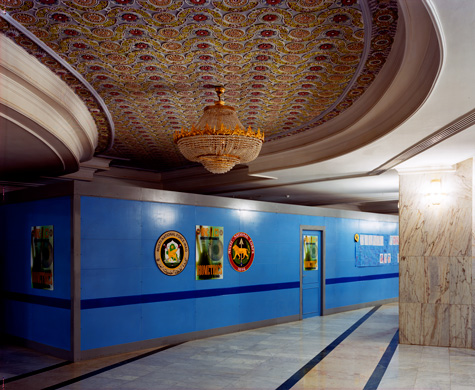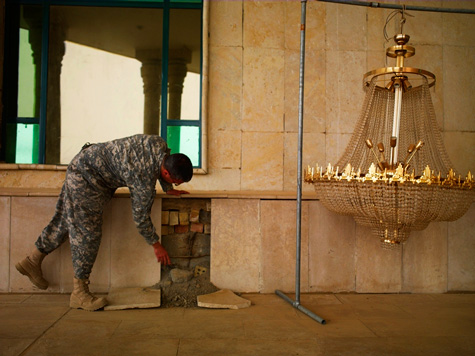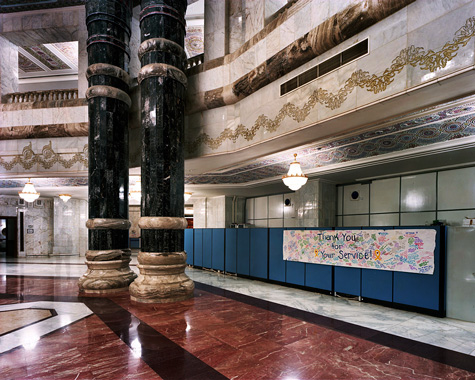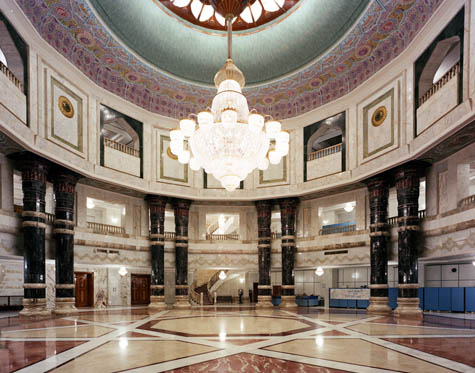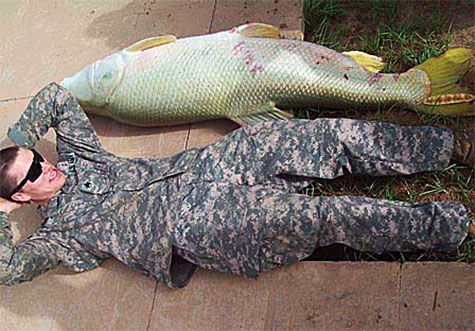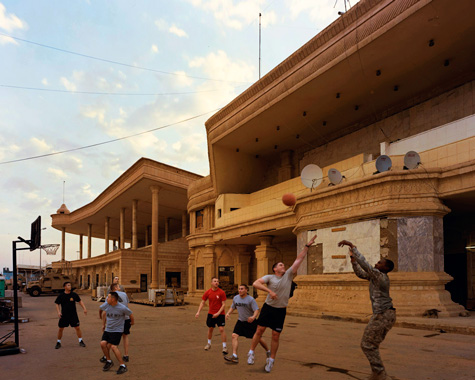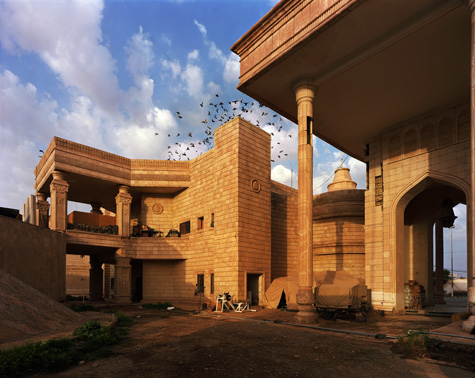BLDGBLOG: I’m interested in the possibility that literary genres might have to be redefined in light of climate change. In other words, a novel where two feet of snow falls on Los Angeles, or sand dunes creep through the suburbs of Rome, would be considered a work of science fiction, even surrealism, today; but that same book, in fifty years’ time, could very well be a work of climate realism, so to speak. So if climate change is making the world surreal, then what it means to write a “realistic” novel will have to change. As a science fiction novelist, does that affect how you approach your work?
Kim Stanley Robinson: Well, I’ve been saying this for a number of years: that now we’re all living in a science fiction novel together, a book that we co-write. A lot of what we’re experiencing now is unsurprising because we’ve been prepped for it by science fiction. But I don’t think surrealism is the right way to put it. Surrealism is so often a matter of dreamscapes, of things becoming more than real– and, as a result, more sublime. You think, maybe, of J.G. Ballard’s The Drowned World, and the way that he sees these giant catastrophes as a release from our current social set-up: catastrophe and disaster are aestheticized and looked at as a miraculous salvation from our present reality. But it wouldn’t really be like that.
I started writing about Earth’s climate change in the Mars books. I needed something to happen on Earth that was shocking enough to allow a kind of historical gap in which my Martians could realistically establish independence. I had already been working with Antarctic scientists who were talking about the West Antarctic Ice Sheet, and how unstable it might be – so I used that, and in Blue MarsI showed a flooded London. But after you get past the initial dislocations and disasters, what you’ve got is another landscape to be inhabited – another situation that would have its own architecture, its own problems, and its own solutions.
To a certain extent, later, in my climate change books, I was following in that mold with the flood of Washington DC. I wrote that scene before Katrina. After Katrina hit, my flood didn’t look the same. I think it has to be acknowledged that the use of catastrophe as a literary device is not actually adequate to talk about something which, in the real world, is often so much worse – and which comes down to a great deal of human suffering.
So there may have been surreal images coming out of the New Orleans flood, but that’s not really what we take away from it.
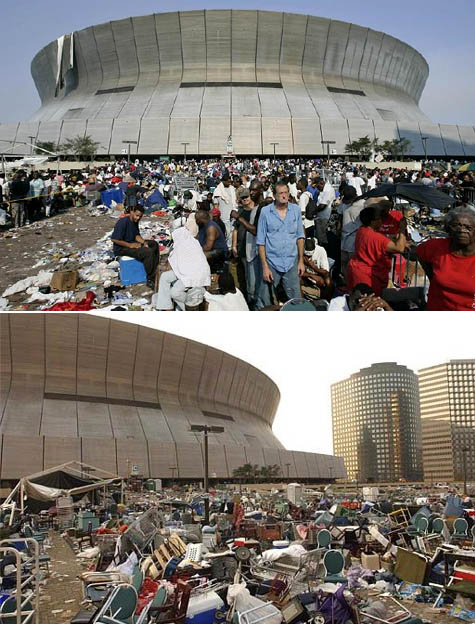
[Image: Refugees gather outside the Superdome, New Orleans, post-Katrina].
BLDGBLOG: Aestheticizing these sorts of disasters can also have the effect of making climate change sound like an adventure. In Fifty Degrees Below, for instance, you wrote: “People are already fond of the flood… It was an adventure. It got people out of their ruts.” The implication is that people might actually beexcited about climate change. Is there a risk that all these reports about flooded cities and lost archipelagoes and new coastlines might actually make climate change sound like some sort of survivalist adventure?
Robinson: It’s a failure of imagination to think that climate change is going to be an escape from jail – and it’s a failure in a couple of ways.
For one thing, modern civilization, with six billion people on the planet, lives on the tip of a gigantic complex of prosthetic devices – and all those devices have to work. The crash scenario that people think of, in this case, as an escape to freedom would actually be so damaging that it wouldn’t be fun. It wouldn’t be an adventure. It would merely be a struggle for food and security, and a permanent high risk of being robbed, beaten, or killed; your ability to feel confident about your own – and your family’s and your children’s – safety would be gone. People who fail to realize that… I’d say their imaginations haven’t fully gotten into this scenario.
It’s easy to imagine people who are bored in the modern techno-surround, as I call it, and they’re bored because they have not fully comprehended that they’re still primates, that their brains grew over a million-year period doing a certain suite of activities, and those activities are still available. Anyone can do them; they’re simple. They have to do with basic life support and basic social activities unboosted by technological means.
And there’s an addictive side to this. People try to do stupid technological replacements for natural primate actions, but it doesn’t quite give them the buzz that they hoped it would. Even though it looks quite magical, the sense of accomplishment is not there. So they do it again, hoping that the activity, like a drug, will somehow satisfy the urge that it’s supposedly meant to satisfy. But it doesn’t. So they do it more and more – and they fall down a rabbit hole, pursuing a destructive and high carbon-burn activity, when they could just go out for a walk, or plant a garden, or sit down at a table with a friend and drink some coffee and talk for an hour. All of these unboosted, straight-forward primate activities are actually intensely satisfying to the totality of the mind-body that we are.
So a little bit of analysis of what we are as primates – how we got here evolutionarily, and what can satisfy us in this world – would help us to imagine activities that are much lower impact on the planet and much more satisfying to the individual at the same time. In general, I’ve been thinking: let’s rate our technologies for how much they help us as primates, rather than how they can put us further into this dream of being powerful gods who stalk around on a planet that doesn’t really matter to us.
Because a lot of these supposed pleasures are really expensive. You pay with your life. You pay with your health. And they don’t satisfy you anyway! You end up taking various kinds of prescription or non-prescription drugs to compensate for your unhappiness and your unhealthiness – and the whole thing comes out of a kind of spiral: if only you could consume more, you’d be happier. But it isn’t true.
I’m advocating a kind of alteration of our imagined relationship to the planet. I think it’d be more fun – and also more sustainable. We’re always thinking that we’re much more powerful than we are, because we’re boosted by technological powers that exert a really, really high cost on the environment – a cost that isn’t calculated and that isn’t put into the price of things. It’s exteriorized from our fake economy. And it’s very profitable for certain elements in our society for us to continue to wander around in this dream-state and be upset about everything.
The hope that, “Oh, if only civilization were to collapse, then I could be happy” – it’s ridiculous. You can simply walk out your front door and get what you want out of that particular fantasy.

[Image: New Orleans under water, post-Katrina; photographer unknown].
BLDGBLOG: Mars has a long history as a kind of utopian destination – and, in that, your Mars trilogy is no exception. What is it about Mars that brings out this particular kind of speculation?
Robinson: Well, it brings up an unusual modern event that can happen in our mental landscapes, which is comparative planetology. That wasn’t really available to us before the modern era – really, until Viking.
One thing about Mars is that it’s a radically impoverished landscape. You start with nothing – the bare rock, the volatile chemicals that are needed for life, some water, and an empty landscape. That makes it a kind of gigantic metaphor, or modeling exercise, and it gives you a way to imagine the fundamentals of what we’re doing here on Earth. I find it is a very good thing to begin thinking that we are terraforming Earth – because we are, and we’ve been doing it for quite some time. We’ve been doing it by accident, and mostly by damaging things. In some ways, there have been improvements, in terms of human support systems, but there’s still so much damage, damage that’s gone unacknowledged or ignored, even when all along we knew it was happening. People kind of shrug and think: a) there’s nothing we can do about it, or b) maybe the next generation will be clever enough to figure it out. So on we go.





[Images: Mars, courtesy of NASA].
Mars is an interesting platform where we can model these things. But I don’t know that we’ll get there for another fifty years or so – and once we do get there, I think that for many, many years, maybe many decades, it will function like Antarctica does now: it will be an interesting scientific base that teaches us things and is beautiful and charismatic, but not important in the larger scheme of human history on Earth. It’s just an interesting place to study, that we can learn things from. Actually, for many years, Mars will be even less important to us than Antarctica, because the Antarctic is at least part of our ecosphere.
But if you think of yourself as terraforming Earth, and if you think about sustainability, then you can start thinking about permaculture and what permaculture really means. It’s not just sustainable agriculture, but a name for a certain type of history. Because the word sustainability is now code for: let’s make capitalism work over the long haul, without ever getting rid of the hierarchy between rich and poor and without establishing social justice.
Sustainable development, as well: that’s a term that’s been contaminated. It doesn’t even mean sustainable anymore. It means: let us continue to do what we’re doing, but somehow get away with it. By some magic waving of the hands, or some techno silver bullet, suddenly we can make it all right to continue in all our current habits. And yet it’s not just that our habits are destructive, they’re not even satisfying to the people who get to play in them. So there’s a stupidity involved, at the cultural level.
BLDGBLOG: In other words, your lifestyle may now be carbon neutral – but was it really any good in the first place?
Robinson: Right. Especially if it’s been encoding, or essentially legitimizing, a grotesque hierarchy of social injustice of the most damaging kind. And the tendency for capitalism to want to overlook that – to wave its hands and say: well, it’s a system in which eventually everyone gets to prosper, you know, the rising tide floats all boats, blah blah – well, this is just not true.
We should take the political and aesthetic baggage out of the term utopia. I’ve been working all my career to try to redefine utopia in more positive terms – in more dynamic terms. People tend to think of utopia as a perfect end-stage, which is, by definition, impossible and maybe even bad for us. And so maybe it’s better to use a word like permaculture, which not only includes permanent but also permutation. Permaculture suggests a certain kind of obvious human goal, which is that future generations will have at least as good a place to live as what we have now.
It’s almost as if a science fiction writer’s job is to represent the unborn humanity that will inherit this place – you’re speaking from the future and for the future. And you try to speak for them by envisioning scenarios that show them either doing things better or doing things worse – but you’re also alerting the generations alive right now that these people have a voice in history.
The future needs to be taken into account by the current system, which regularly steals from it in order to pad our ridiculous current lifestyle.

[Images: (top) Michael Reynolds, architect. Turbine House, Taos, New Mexico. Photograph © Michael Reynolds, 2007. (bottom) Steve Baer, designer. House of Steve Baer, Corrales, New Mexico, 1971. Photography © Jon Naar, 1975/2007. Courtesy of the Canadian Centre for Architecture, from their excellent, and uncannily well-timed, exhibition 1973: Sorry, Out of Gas].
BLDGBLOG: When it actually comes to designing the future, what will permaculture look like? Where will its structures and ideas come from?
Robinson: Well, at the end of the 1960s and through the 70s, what we thought – and this is particularly true in architecture and design terms – was: OK, given these new possibilities for new and different ways of being, how do we design it? What happens in architecture? What happens in urban design?
As a result of these questions there came into being a big body of utopian design literature that’s now mostly obsolete and out of print, which had no notion that the Reagan-Thatcher counter-revolution was going to hit. Books like Progress As If Survival Mattered, Small Is Beautiful, Muddling Toward Frugality, The Integral Urban House, Design for the Real World, A Pattern Language, and so on. I had a whole shelf of those books. Their tech is now mostly obsolete, superceded by more sophisticated tech, but the ideas behind them, and the idea of appropriate technology and alternative design: that needs to come back big time. And I think it is.


 I wish Kamil Khan Mumtaz best wishes and luck in the world. He has already started a debate and highlighted the issues, which are crucial for the well-being and future of architecture and has produced many exemplary buildings to prove his points. His efforts have already introduced many craftsmen to the lost art of traditional building materials and techniques. May this long continue and multiply.
I wish Kamil Khan Mumtaz best wishes and luck in the world. He has already started a debate and highlighted the issues, which are crucial for the well-being and future of architecture and has produced many exemplary buildings to prove his points. His efforts have already introduced many craftsmen to the lost art of traditional building materials and techniques. May this long continue and multiply.